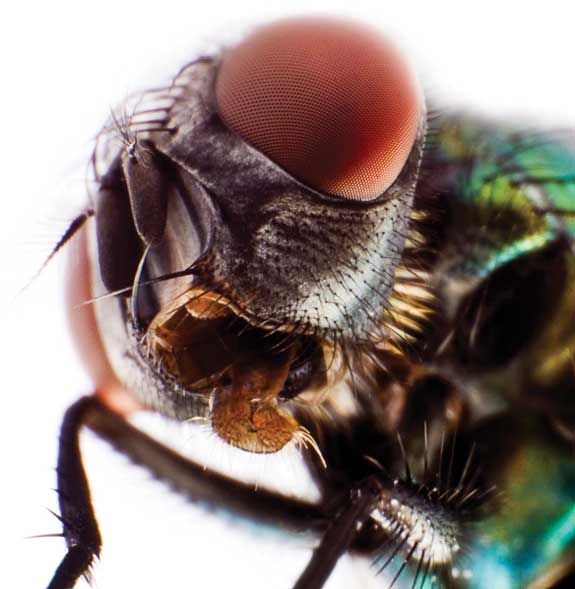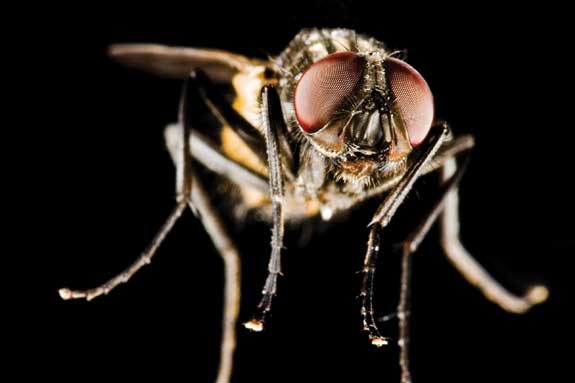In previous articles, the two most important dairy fly pests have been discussed. This article will discuss other flying pests that may be encountered on the dairy, their economic importance and possible management and control techniques if they are a problem. Some of these pests are very sporadic in their appearance and may be limited to more specific geographic areas.
If you are a grazer or if your dairy is close to pastured animals you will probably have a small fly about half the size of a house fly that is found on the backs and sides of your cows. This is the horn fly. It got its name from the habit of congregating around the base of horned animals to feed. Horn flies are blood feeders and can significantly affect cattle weight gains and milk production by 25 percent. However, a recognized economic threshold (when they start costing you more money than the treatment cost) is 200 flies per animal.
Horn flies only breed in an undisturbed manure pat and will not develop in confined pens that have the manure trampled or disturbed. Often we will find small numbers of them on the backs of confined cattle but seldom enough to cause an economic loss. Those present migrated in from adjoining pastures with cattle present. When the horn fly emerges from the pupal stage, which occurs in or near the undisturbed manure pat, the adult will start a search for another host and can fly for some distance. However, since they are not able to reproduce in disturbed manure, they will normally never reach very high numbers on confined animals. They may also be found on other animals such as horses but cannot reproduce in the manure of most other species such as sheep, goats, horses, etc.

If horn flies are a problem, they can be controlled with insecticide ear tags, sprays, dust, back rubbers, etc. These products kill the flies that have migrated to the animals but will not stop the influx of new horn flies. Parasitic wasps will also help reduce horn fly numbers and are used effectively in intensively grazed and small pastures. However, it is very important to distribute the wasp in a grid-like fashion within 150 feet of undisturbed cow pats. Typically you release these weekly in the pasture sections where the cows have been for the last three to four days and will be in the next three to four days.
For dairymen, probably the next-most frequently seen pest would be the deer and horse flies. They may be called other local names, such as cedar flies or green heads depending on your geographic location. Deer flies are smaller than horse flies but have a very similar life cycle. These are more of a pest on pasture animals, especially those close to areas of streams, lakes and other types of water. The adults will often roost in the vegetation, waiting for a warm-blooded animal to come past. These pests are very strong fliers and can fly for several miles in search of a blood meal.
The immature stages are semi-aquatic and develop along stream banks and other similar areas. The adults are very painful blood feeders and are extremely difficult to control. Due to their site of immature development, the parasitic wasps have no impact on the pupal stage. Insecticides cannot be used because of the environmental contamination and would not be very effective. Sprays and repellents applied to your animals may provide some relief but only for short periods of time due to the short residual of those products. There are specific traps available (www.horsepal.info and Epps) that will help capture adults but may be of limited use with large numbers of animals. Avoidance of pastures with heavy populations of deer and horse flies is about the best you can do.
Another pest that is seen in some geographic areas is the face fly and is primarily found in areas of higher rainfall, especially the eastern U.S. The face fly is about the size of a house fly and is primarily found on the animalâs face, especially around the eyes and muzzle. They, like the horn fly, only develop in undisturbed manure pats and are seldom a problem with confined animals. In areas with this problem, they may have developed a strong resistance to pesticides and are difficult to control. In confined dairies, this fly is seldom a pest. The parasitic wasps will have limited benefit since the pupal case of the face fly is thicker and difficult to penetrate by the wasp. However, some reduction of face flies may occur from use of parasitic wasps.
Another pest that is seen bothering cattle and people in areas with streams and irrigation canals is the black fly or buffalo gnat. They are tiny blood-sucking flies that are aquatic in the immature stages and require uncontaminated moving water to develop. They are not to be confused with the gnats that often appear on wet, fresh manure areas on the dairy. They are especially a problem in the northern U.S. and Canada. Outbreaks are reported from other areas but usually only sporadically. They are daytime feeders and rarely venture indoors. The adults only live three to four weeks and usually disappear in the hotter summer months. Pesticides can be used but require frequent application. Read and follow the label before any pesticides are used.
There are a number of other species of flies (Diptera) that might be found in and around a dairy. The lesser house fly is smaller than the house fly and has very similar life cycle and control methods. Blow flies almost breed exclusively in decaying animal matter and will have several generations per year. They are seldom a problem but in the fall, their search for overwintering sites around the house and barn may cause some concern. Proper disposal of deceased animals will help keep their numbers down.
Flesh flies are similar to blow flies in their biology and are attracted to odors of decay. They may be found breeding in manure, decaying vegetation, animal carcasses and on dead snails and larger insects. The adults do not bite but feed on a wide range of liquid substances. Occasionally, the larvae will infest wounds and feed on the dead tissue. They are also beneficial from the standpoint that the larvae also feed on the immature stages of harmful insects such as the stable and house fly.
Dung flies breed in animal dung, decaying plant material, rotting vegetation and mud along shorelines. The adults are predatory and feed on the adults of other flies that come to the dung to feed. Although the adults resemble bees in appearance, they are considered beneficial and harmless to people and livestock.
Control of these various species of flies is often difficult but fortunately, most are only an occasional pest and may not warrant a control or management program. As with the house and stable fly, good sanitation and manure management will help on those mentioned species that develop in decaying organic matter. Composting of carcasses, if done correctly, will keep blow flies to a minimum and shouldnât warrant any specific control. PD
For additional information in both English and Spanish go to www.spalding-labs.com

-
Bill Clymer
- Senior Scientist
- Spalding Laboratories
- Email Bill Clymer






